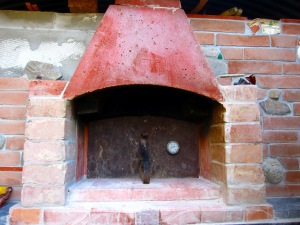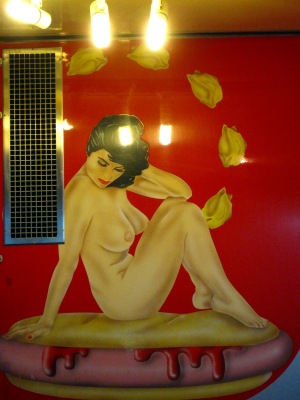A falcon catches a lure mid-air.
After a 7 hour battle for seating on a hot, overbooked train, I stepped off the platform in San Miniato and took a good look around. This was Italy’s famed Tuscany, the stuff that Hollywood movies and expat marriage dreams are made of. All was quiet, and I paused uncertainly as I looked at the empty train station waiting room. If I were a WWOOF host, where would I be, I thought to myself. My worries were allayed however, when I spotted a woman waiting around the corner. She approached me with a smile and said, “Hi, are you Crystal? I’m Amy, nice to meet you, I’m glad that you made it!”
Amy quickly introduced herself and told me about the Barbialla Nuova farm, where I am volunteering through WWOOF for the next couple weeks. In no time, we were trading life stories and discussing how the shape of bread across cultures is influenced by the way it is used (flatbreads for curry in India vs round disks used as bowls for stew in England). Amy moved from Australia to Italy with her husband and two young children about 9 months ago, after deciding that they wanted to spend some time living abroad. Ken, her husband, is a very talented bread baker and they both have extensive experience as WWOOFers around the world. After sending out inquiries to the WWOOF network, they stumbled upon Barbialla Nuova and haven’t left since. “It’s really neat to be on the other side now as a host!” commented Amy.
Barbialla Nuova is a 500-hectare farm in central Tuscany, and the project aspires to govern the land as a holistic living organism, with knowledge from the biodynamic, sustainable and Fukuoka schools of natural agriculture. The farm holds a herd of 60+ Chianina cattle, pigs, a lake for fishing, and some of the most valuable natural white truffle beds of the Val d’Elsa. More than half of the property is wooded, and much of the remaining land is set aside for grazing animals. Wild boars, deer, hares and porcupines are some of the animals that are commonly seen on the grounds. At one point, there were about 50 farmhouses on the property, and the 1861 census records state that 382 people lived on the estate at that time, with each family given a house and some land in exchange for half of the profits. Even further back in history, Barbialla was underwater during the Pliocene era, and in some of the layers of rock, you can find marine fossils of gastropods and bivalves.
Clockwise: my new digs for the next two weeks; literature selection on the shelves includes “Il Grande Gatsby,” (my favorite) travel writer Bill Bryson, and La Dvina Commedia; Barbialla Nuova’s newly built wood-fired oven includes colorful seashells in the brickwork; an assortment of pans and skillets in the kitchen
After handing me a map of the extensive property, Amy showed me to my quarters. Much to my delight, the Vallibonci house is a charming, ramshackle farmhouse, full of woodcarved benches, curious spiders and unsecured wifi access. There is no cell phone reception. I have my own room and a private bathroom, and there is an eclectic collection of reading material on the shelves, mostly in English and Italian. On a shelf, I found a 20 cent piece from Hong Kong, presumably left by a previous WWOOFer. It was the first coin I had ever seen with wavy edges.
Amy gave me a basket filled with vegetables, fresh milk, and other sundries and explained that we would be having lunch or dinner together every day, and I had free reign to cook whatever I wanted for my other meals. “It’s kind of like being on one of those cooking shows, you have to use whatever ingredients are in front of you,” Amy joked. “Excellent,” I beamed. “Actually, I happened to be in a cooking competition just last week in Zurich…”
For the rest of the evening, Amy and Ken had been planning on taking the kids to a medieval horse and falcon festival in Monteriggioni, about an hour’s drive away. They asked if I was feeling tired, and invited me to come along if I was interested. Horses, falcons and eagles?! This city slicker didn’t need to be asked twice.
Clockwise: a falconeer, his bird and his horse; the entrance to Monteriggioni; artwork on the side of a food truck selling meat and panini at the horse & falcon show; sign indicating hospitality is available for pilgrims
Monteriggioni is a little hamlet outside of Siena, founded in 1214 and contained by the original castle walls. The castle can be seen from the Florence-Siena highway, which probably results in a lot of spontaneous detours. The town is part of the medieval pilgrimage route from Coventry, England to Rome, so you will often see pilgrims in town, there for a quick respite from their trip. Yes, despite this being the 21st century, people still walk the 3-month journey. At first I thought this was nearly bonkers, but then I remembered how I wouldn’t mind spending 6 months hiking the Appalachian Trail, so I’ll stop calling the kettle black.
For the last two days, an exhibition with horses and falconeers was taking place just outside the castle grounds. The program also promised hunting horns, a fox hunt and hounds. Unfortunately, I couldn’t understand much of the Italian commentary, but I still watched mesmerized as the falconeer spun a leather lure through the air. It whistled as it spun overhead, and the wayward falcon eventually returned at his master’s behest, catching the lure mid-air as the falconeer tossed it over his head.
Amusingly enough, of the half-dozen falcons that we saw during the performance, only two of them returned to their falconeers, and the rest simply took off into the distant hills. Later, you could see the falconeers pulling out lightning-rod shaped radio transmitter wands, valiantly trying to detect which direction their birds had gone. Alongside the main performance ring, there was a showcase of large hawks and various birds of pray, including owls and an African eagle. Like horses that draw carriages, many of the birds had masks on them to cover their eyes. I wonder if this makes them less antsy and prone to flying off? It was quite clear that even highly trained birds were not inclined to stay put.
Finally, here’s the first breakfast I cooked on the farm: omelet with onions and pesto, a couple pieces of Ken’s sourdough bread with quince preserves and a few slices of tomato, all washed down with a cold glass of creamy milk from the cows outside. On Friday, Ken will be hosting a bread-making class, so I think I might peek in on his secrets.









